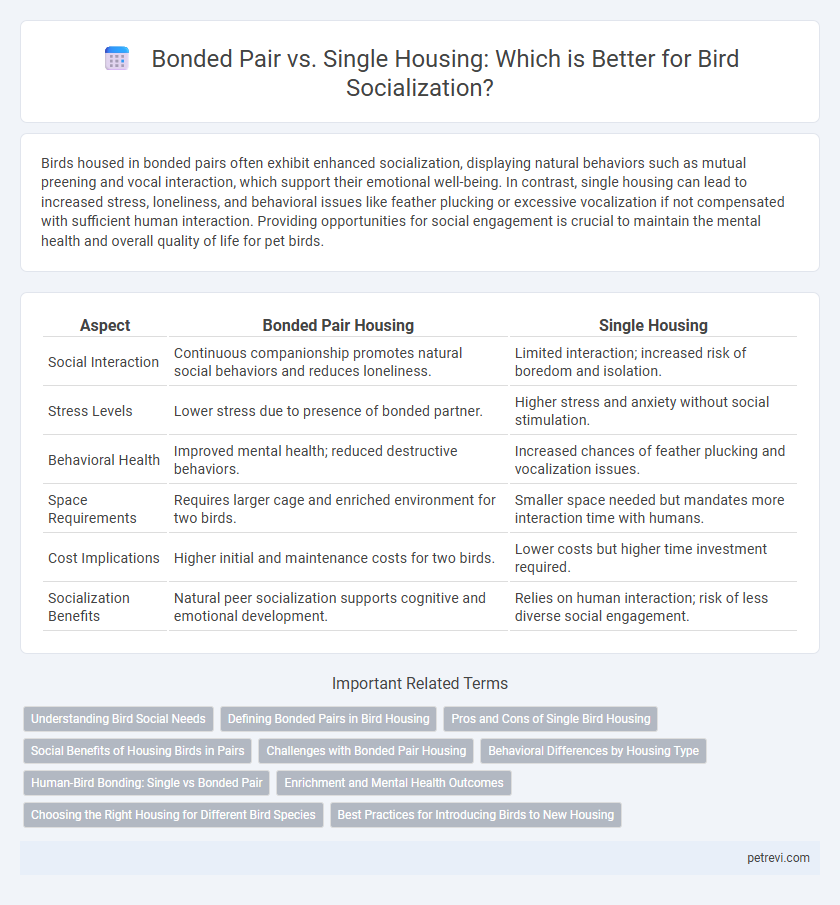Birds housed in bonded pairs often exhibit enhanced socialization, displaying natural behaviors such as mutual preening and vocal interaction, which support their emotional well-being. In contrast, single housing can lead to increased stress, loneliness, and behavioral issues like feather plucking or excessive vocalization if not compensated with sufficient human interaction. Providing opportunities for social engagement is crucial to maintain the mental health and overall quality of life for pet birds.
Table of Comparison
| Aspect | Bonded Pair Housing | Single Housing |
|---|---|---|
| Social Interaction | Continuous companionship promotes natural social behaviors and reduces loneliness. | Limited interaction; increased risk of boredom and isolation. |
| Stress Levels | Lower stress due to presence of bonded partner. | Higher stress and anxiety without social stimulation. |
| Behavioral Health | Improved mental health; reduced destructive behaviors. | Increased chances of feather plucking and vocalization issues. |
| Space Requirements | Requires larger cage and enriched environment for two birds. | Smaller space needed but mandates more interaction time with humans. |
| Cost Implications | Higher initial and maintenance costs for two birds. | Lower costs but higher time investment required. |
| Socialization Benefits | Natural peer socialization supports cognitive and emotional development. | Relies on human interaction; risk of less diverse social engagement. |
Understanding Bird Social Needs
Bonded pairs of birds exhibit enhanced social interaction, reducing stress and promoting natural behaviors compared to single housing, which can lead to loneliness and behavioral issues. Understanding bird social needs involves recognizing species-specific tendencies for companionship, as many birds thrive in environments that mimic their natural flock settings. Providing bonded pairs supports mental stimulation and emotional well-being, crucial factors in preventing feather plucking and aggression often seen in solitary birds.
Defining Bonded Pairs in Bird Housing
Bonded pairs in bird housing refer to two birds that form a strong social and emotional connection, often grooming, feeding, and perching closely together. This bond promotes psychological well-being and reduces stress by providing companionship, mimicking natural flock dynamics. Single housing, lacking this interaction, can lead to loneliness and behavioral issues, highlighting the importance of bonded pairs for optimal socialization.
Pros and Cons of Single Bird Housing
Single bird housing offers individualized care, reducing stress caused by territorial disputes common in bonded pairs. However, lack of social interaction may lead to loneliness and behavioral issues like feather plucking or excessive vocalization. Providing ample human interaction and environmental enrichment can mitigate some negative effects of single housing.
Social Benefits of Housing Birds in Pairs
Housing birds in bonded pairs significantly enhances their social welfare by providing constant companionship, which reduces stress and anxiety levels. Paired birds engage in mutual preening, vocalizations, and interactive play that stimulate mental and emotional health. This social environment mimics natural flock dynamics, promoting healthier behaviors and overall longevity in captive birds.
Challenges with Bonded Pair Housing
Bonded pair housing for birds can lead to complex social dynamics, including dominance disputes and increased aggression, which may result in physical injury or stress. Birds in bonded pairs often require careful monitoring to prevent resource guarding over food, toys, or space, which single-housed birds typically avoid. Managing bonded pairs demands commitment to consistent behavioral observation and intervention to maintain harmony and mental well-being.
Behavioral Differences by Housing Type
Bonded pairs of birds exhibit increased social interaction, reduced stress behaviors, and enhanced vocal communication compared to single-housed birds, which may display signs of loneliness, excessive vocalization, or self-destructive behaviors like feather plucking. Birds housed together often engage in mutual preening and synchronized activities that contribute to emotional well-being and cognitive stimulation. Single housing can lead to heightened anxiety and reduced natural behaviors, underscoring the importance of social companionship for species with strong flock instincts.
Human-Bird Bonding: Single vs Bonded Pair
Birds housed as a bonded pair often exhibit stronger social interactions and reduced stress behaviors, enhancing natural communication and companionship. Single housing can intensify the bird's need for human interaction, potentially deepening the human-bird bond if daily attention and enrichment are provided. Optimal socialization depends on balancing species-specific needs with consistent, positive human engagement to support mental and emotional well-being.
Enrichment and Mental Health Outcomes
Bonded pairs of birds exhibit higher levels of enrichment and improved mental health outcomes compared to singly housed birds, as social interaction stimulates natural behaviors and reduces stress-related symptoms. Single housing often leads to boredom, feather plucking, and increased anxiety due to the lack of social stimuli and environmental complexity. Providing a bonded pair enhances cognitive engagement through mutual preening, vocalization, and cooperative play, promoting overall well-being and longevity in avian companions.
Choosing the Right Housing for Different Bird Species
Bonded pairs of birds, such as budgerigars and cockatiels, thrive in shared housing environments that promote social interaction and reduce stress, while solitary species like certain parrots and finches often require single housing to prevent territorial aggression. Providing species-specific housing ensures optimal mental health and behavioral development by catering to natural social tendencies and spatial needs. Proper cage size, enrichment, and observation are crucial for maintaining social harmony and overall well-being across different bird species.
Best Practices for Introducing Birds to New Housing
When introducing birds to new housing, maintaining bonded pairs in shared enclosures significantly reduces stress and promotes natural social behaviors compared to single housing. Ensuring gradual acclimation through adjacent cages before full cohabitation helps prevent aggression and fosters positive interaction. Optimal environmental enrichment and frequent monitoring support healthy socialization and overall well-being during the transition.
Bonded Pair vs Single Housing for Bird Socialization Infographic

 petrevi.com
petrevi.com